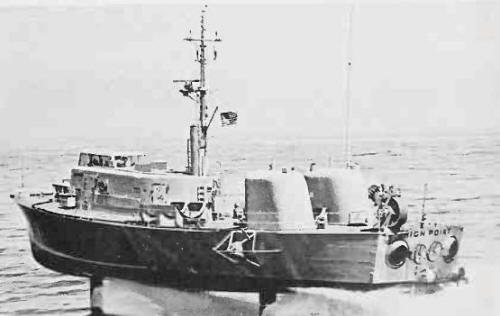

High Point 1965
| No | Name | Yard No | Builder | Laid down | Launched | Comm | Fate |
| PCH1, 4.1975- WMEH1, 5.1975- PCH1 | High Point | Martinac, Tacoma // Boeing, Seattle | 2.1961 | 17.8.1962 | 8.1963 | Coast Guard cutter 4.1975-5/1975, stricken 1980 |
|
Displacement standard, t |
94 |
|
Displacement full, t |
120 |
|
Length, m |
33.5 wl 35.3 oa |
|
Breadth, m |
9.50 |
|
Draught, m |
1.20 |
|
No of shafts |
2 with paired counter-rotating propellers (foil-borne) / 1 retractable outdrive (hull-borne) |
|
Machinery |
2 Bristol Siddeley Marine Proteus gas turbines / 1 Curtis Wright diesel |
|
Power, h. p. |
6800 / 600 |
|
Max speed, kts |
45 / 12 |
|
Fuel, t |
diesel oil |
| Endurance, nm(kts) | |
|
Armament |
1 x 2 - 12.7/90, 2 x 2 - 324 Mk 32 TT, 1 DCR |
|
Electronic equipment |
radar, sonar |
| Complement | 13 |
Project history: Hydrofoils were the major exception to US Navy lack of interest in fast patrol craft during the 1950s; they were so promising a technology that they could not be ignored. At that time the primary naval problems was ASW. and it was for ASW that the first large US hydrofoil, the High Point (PCH1, SCB 202 of FY60), was designed. It was to function in a 'sprint and drift' mode, listening briefly between high speed dashes. Because it could not really hope to listen while moving at high speed, it would have to operate in pairs, one unit vectoring the other into an attack with homing torpedoes. A large hull sonar would be retracted into the hull at high speed, and extended during low-speed hull-borne operation. There was also an auxiliary sonar, either a variable-depth unit for deep operation, or a towed unit which might provide some limned capability even at speed. There were, in addition, exotic operational concepts, such as buoy-borne MAD for target classification during an attack.
Interest in such ASW hydrofoils dated from about January 1955, although it appears that there was information concerning Soviet experiments the previous year. In February 1956 the Office of Naval Research began operational evaluation of hydrofoil craft systems for ASW. Meanwhile, conventional coastal ASW craft (SC and PCS) were repeatedly included in proposed shipbuilding plans, but were always dropped due to their low priority. In January 1958, however, the CNO asked the Bureau of Ships to study the use of hydrofoil craft for harbour security, and that April the PCH was substituted for the usual combination of PCS and SC prototype in the FY60 budget. Probably largely because of its innovative character, the PCH did survive the FY60 pruning of the budget. Originally several follow-on craft were proposed. For example, an October 1958 proposal for the FY61 budget carried three PCH (as well as a variety of other doomed craft, such as a missile-armed barrier patrol ship, or PBG, five of which were to have been bought).
In fact, only one PCH was built, and it functioned as an experimental boat.
Modernizations: 1968: + 1 x 1 - 40/60 Mk 3 (temporarily for tests)
1973-1974: + 1 x 4 Harpoon SSM (4 RGM-84) (temporarily for tests)
Fate notes: No significant events.

High Point 1963
© Ivan Gogin, 2014